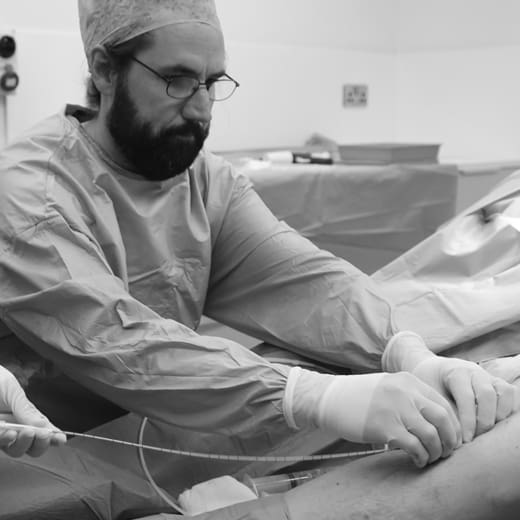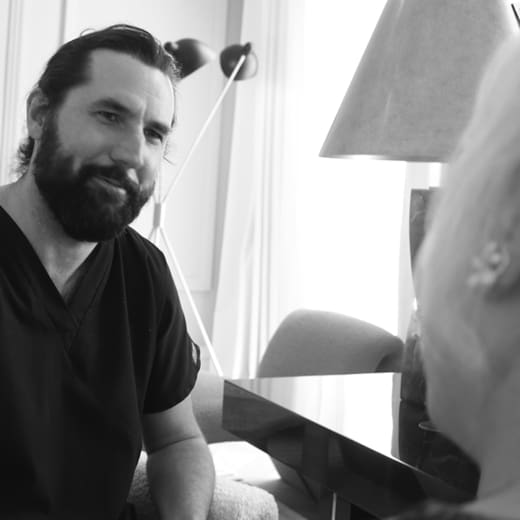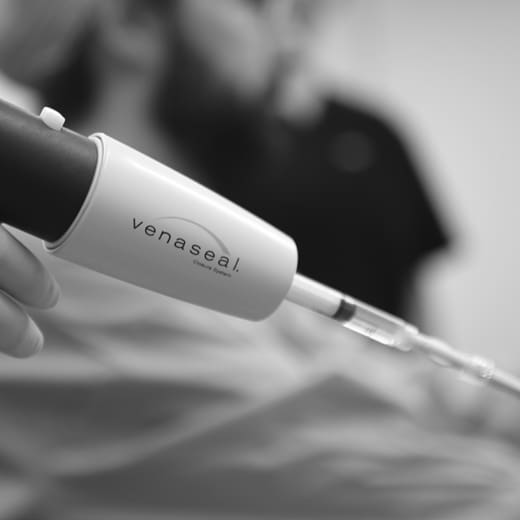McKeown Medical
167 Bath Street, Glasgow, G2 4SQ
Date posted — 2.10.24
If you’re struggling with the discomfort, swelling, or unsightly appearance of varicose veins, Radiofrequency Ablation (RFA) could be the solution you’ve been looking for. This minimally invasive procedure uses radiofrequency energy to target and close off problematic veins, providing long-lasting relief with less discomfort and downtime than traditional surgery.
In this guide, we’ll explore everything you need to know about RFA – from how it works to what you can expect during the procedure, what the recovery is, and the benefits it offers over other treatment options and the benefits some newer treatments like VenaSeal™ might have over RFA. Ultimately, there are lots of choices when it comes to treating varicose veins.

RFA is a minimally invasive medical procedure used to treat varicose veins by using radiofrequency energy to heat and close off the affected veins. It is part of a group of techniques referred to as ‘endovascular’ procedures because they involve operating inside the vein rather than outside of it in the traditional approach. RFA involves inserting a small catheter into the vein, where radiofrequency energy is delivered, causing the vein walls to contract, collapse, and eventually be absorbed by the body.
RFA was introduced in the late 1990s and early 2000s as an alternative to more invasive surgical treatments like vein stripping. Around the same time, another option known as endovenous laser ablation (EVLA) was also developed.
EVLA employs a very similar technique by delivering heat to destroy the inside of the problematic blood vessels, although it uses laser energy to deliver the heat. Both RFA and EVLA are similarly very effective, although RFA is associated with fewer side effects and is generally considered to be the superior method.
Dr Alex Vesey is our expert consultant vascular surgeon who heads up our varicose vein team. Listen to him explain the RFA treatment.

Before: Before the procedure, you’ll first have a consultation with a specialist vascular surgeon who will assess your varicose veins from taking a medical history, performing a thorough examination and an ultrasound scan to assess the anatomy of your veins. This helps determine the best veins to treat and ensures that RFA is the right option for you. On the day of the procedure, you’ll be asked to wear loose-fitting clothing and underwear that you don’t mind getting antiseptic on. You will be asked to sign an informed consent form before you go into the treatment room (a copy of this will be emailed to you in advance so you have plenty of time to read before you sign).
During: The procedure begins with the patient lying down on the treatment table and the affected leg is then cleaned and sterile drapes are applied. The doctor then makes a small incision near the knee or lower leg to insert a thin catheter into the problematic vein, guided by ultrasound imaging for precise placement. The doctor then injects a high volume of dilute anaesthetic – known as tumescent anaesthetic – along the length of the vein to be treated. As well as providing anaesthesia, this also helps to absorb the heat that is delivered to the vein during the procedure and reduces the chances of injuring surrounding tissues, like nerves. The catheter position is then rechecked and radiofrequency energy is delivered through the catheter, heating the vein walls and causing them to collapse and seal shut. This process is repeated along the length of the vein, effectively closing it off. The procedure typically takes about 30 to 60 minutes.
After: After the RFA procedure, a compression bandage or stocking is applied to the treated leg to help reduce swelling and promote healing. Most patients can stand up and walk immediately after the procedure, which is encouraged to help circulation. You may experience some discomfort, bruising, or swelling, but these symptoms usually subside within a few days. It’s generally recommended to avoid strenuous activities for about a week, but most people can return to their normal routines within a day or two. We will arrange to see you back in the clinic to assess the results, typically a few months after treatment since this is how long it takes for the veins to be reabsorbed by the body and for us to be able to assess the outcome.
Endovascular treatment with RFA offers significant benefits over traditional surgery for treating varicose veins.
One of the main advantages is its minimally invasive nature, which involves only a small incision and causes far less trauma to the surrounding tissues compared to traditional vein-stripping surgery. This leads to a quicker recovery time, allowing patients to return to their normal activities, often within a day or two, as opposed to the longer downtime required after surgery. RFA also typically results in less pain, bruising, and scarring, which improves patient satisfaction both during and after the procedure.
Additionally, because RFA uses radiofrequency energy to precisely target and close off the affected veins, it reduces the risk of complications such as nerve damage, which can be more common in traditional surgical approaches. Not everyone is suitable for RFA – which is why your initial consultation and ultrasound scan assessment are so important to make sure you get the best treatment option for your particular condition.

VenaSeal™ is a more recent innovative and effective option for the endovascular treatment of varicose veins, gaining FDA approval in 2015. VenaSeal™ uses a medical adhesive instead of heat to close off problematic veins.
The procedure involves inserting a small catheter into the vein and applying the adhesive, which bonds the vein walls together, causing the vein to seal shut and be gradually absorbed by the body. Compared to RFA, VenaSeal™ offers several advantages: it requires no heat or tumescent anaesthetic injections, which can reduce discomfort and eliminate the need for compression stockings after the procedure.
Additionally, VenaSeal™ has an even quicker recovery time – often allowing patients to resume normal activities almost immediately. While RFA remains a highly effective treatment with a proven track record, VenaSeal™ offers the same levels of effectiveness with less pain, inconvenience and downtime which is why it now accounts for around 50% of varicose vein treatment in the USA.
We are the first clinic in Scotland to introduce what is now considered to be the gold standard treatment for varicose veins.
If you’d like to find out if Radiofrequency Ablation (RFA) is the right treatment for you, the first step is to fill out our online consultation form. From there, our team will be able to arrange an initial consultation and ultrasound scan, and we can work together to create a treatment plan that is tailored to your needs.

Radiofrequency ablation (RFA) and endovenous laser ablation (EVLA) are two minimally invasive treatments used to effectively treat varicose veins, but...

When it comes to treating varicose veins, VenaSeal™ has emerged as a revolutionary option that offers a minimally invasive and...

Varicose veins are enlarged, twisted veins that often appear just under the skin, primarily in the legs and feet.
1 / 3
2 / 3
3 / 3

Radiofrequency ablation (RFA) and endovenous laser ablation (EVLA) are two minimally invasive treatments used to effectively treat varicose veins, but...

When it comes to treating varicose veins, VenaSeal™ has emerged as a revolutionary option that offers a minimally invasive and...

Varicose veins are enlarged, twisted veins that often appear just under the skin, primarily in the legs and feet.
Thank you to our incredible patient for allowing us to share these pictures with you.
This patient has been with me for years but the thing we have always struggled with has been the texture of the skin around the mouth and lower face which has had a lot of sun over the years.
We’d tried less invasive options but ultimately when the skin changes get to this level the only thing that makes a dramatic improvement is full field resurfacing.
There is literally no other treatment capable of undoing sun damage like this. The patient is only a few weeks post-op and still a bit red so she is wearing make up to hide the redness, but already obsessed by the texture of her new skin.
What do you think?
If you`d like to know if you`d benefit from this treatment send us a DM with some pictures or visit the link in our profile for more information on full laser resurfacing.

We`re going live on Wednesday at 7PM! Join Dr Rhona and Dr Iain (@driainmartin) on Instagram live, where they`ll be discussing everything about periods and heavy menstrual bleeding including:
What is “normal” when it comes to menstruation
Heavy periods - what is a heavy period and what might be causing it
Myths vs facts - getting the right information and the right treatment for period problems
They`ll also be answering your questions live, so if there`s anything you`d like to ask, leave a comment or head to our stories. We hope you can join us!

Since we are now in full swing filler season, I’m very grateful to this patient for allowing us to share her pictures to demonstrate how much lift we can achieve just using filler.
Discover more about our method at the link in our bio.

Summer is almost here! If you’re putting off wearing your favourite summer dresses and shorts because of varicose veins, now is the time to think about treatment.
Varicose veins aren’t just a cosmetic concern - they can ache and throb, as well as make us feel self-conscious, especially as the warmer weather approaches.
With so many treatments available, it can be difficult to know where to start. Here’s our lovely Dr Alex with a quick overview of how we can help reduce discomfort, improve appearance and boost your confidence in time for summer.
If you, or someone you know, have been thinking about treatment, now is a great time to explore your options with plenty of time to feel the benefits before summer - check the link in our bio for more details.

Now that spring has finally sprung we are very much in peak time for filler treatments in the clinic.
So many patients would benefit from filler, but are scared of them because of the horror stories so I wanted to share a few examples this week of what filler looks like - in the correct hands!
Here are some examples of the natural looks we achieve with the McKeown Method.
Discover more about our method at the link in our bio.

What a difference a week is! This is one of our patients just a week out from her deep plane face and neck lift by the ever so talented @bramhallplasticsurgery.
The deep plane technique is the most technically challenging facelift to perform and Russell remains the only surgeon in Scotland performing this procedure, which involves going much deeper into the face to reposition the tissues rather than just pull them tight.
The outcome is a much more effective rejuvenation, even in unflattering poses when your head is bent forward, and a result that lasts much longer than a traditional facelift.
What do you think?

Thank you so much to our wonderful patient for allowing us to share her before and after pictures. She’s around 6 weeks after full field resurfacing.
One of the great things about this treatment is that, in addition to wiping wrinkles away, it also gives some pretty impressive skin tightening too. If you look at her forehead, upper and lower eyelids you can really see how much tighter the skin is.
The stubborn forehead lines and lines through the eyebrows have gone and, of course, the lines around the mouth are significantly reduced. These will continue to improve for up to six months as the skin continues to heal. She’s still a little pink, which will fade over the next few months, but with a little tinted moisturiser you’d never know. The patient is over the moon.
What do you think?
We can now offer full laser resurfacing with sedation and you can see more about the procedure in the link in our profile.

Yesterday we announced that we’re the first clinic in Scotland to have the CoolSculpting® Elite so today I wanted to show you an example of the kind of results we can achieve with this treatment.
We’re so grateful to this patient for allowing us to share her results before and after CoolSculpting®. As you can see here, she had a stubborn area of fat around her belly which she was finding difficult to shift with diet and exercise alone.
She’s absolutely delighted with the result - what do you think?
For more information on CoolSculpting® and to get booked in to be ready for summer, check out the link in our bio.

Introducing CoolSculpting® Elite!
We’re delighted to announce that we now have the CoolSculpting® Elite, modelled here by our lovely nurse Niki! We’re excited to be the first clinic in Scotland to take delivery of the latest technology from CoolSculpting®, which has new and improved applicators to improve the contact between the machine and the skin, for even better results than before.
Now is the perfect time to have this treatment in time for the summer. To find out more about CoolSculpting® check the link in our bio.
